A Review of Detection Technologies for Underwater Cracks on Concrete Dam Surfaces
Abstract
1. Introduction
2. Common Methods for Detecting Underwater Cracks in the Surface of Concrete Dams
2.1. Manual Visual Inspection
2.2. Intelligent Monitoring Techniques
2.2.1. Acoustic and Vibration Methods
2.2.2. Electromagnetic Methods
2.2.3. Temperature Tracing Method
2.3. Digital Image Detection Method
3. Dam Crack Detection Based on Underwater Robots
3.1. Underwater Robots
3.2. Application of Underwater Robots in Dam Crack Detection
4. Application of Image Processing Techniques to Underwater Crack Detection in Dams
4.1. Problems in Underwater Image Processing
4.2. Image Processing of Underwater Cracks
4.2.1. Underwater Crack Image Preprocessing
4.2.2. Underwater Crack Image Recognition
5. Summary and Conclusions
Author Contributions
Funding
Institutional Review Board Statement
Informed Consent Statement
Data Availability Statement
Acknowledgments
Conflicts of Interest
References
- Huang, L.; Li, X.; Fang, H.W.; Yin, D.Q.; Si, Y.; Wei, J.H.; Liu, J.H.; Hu, X.Y.; Zhang, L. Balancing Social, Economic and Ecological Benefits of Reservoir Operation during the Flood Season: A Case Study of the Three Gorges Project, China. J. Hydrol. 2019, 572, 422–434. [Google Scholar] [CrossRef]
- Ma, H.Q.; Chi, F.D. Technical Progress on Researches for the Safety of High Concrete-Faced Rockfill Dams. Engineering 2016, 2, 332–339. [Google Scholar] [CrossRef]
- Jia, J.S. A Technical Review of Hydro-Project Development in China. Engineering 2016, 2, 302–312. [Google Scholar] [CrossRef]
- Wang, X.L.; Zhou, Z.Y.; Sun, R.R.; Zhou, S.S. Fuzzy Hierarchy Comprehensive Evaluation on Dam-Break Risk Analysis. Adv. Mater. Res. 2012, 383–390, 2151–2155. [Google Scholar] [CrossRef]
- Su, H.Z.; Ren, J.; Wen, Z.P. An Approach Using Dempster-Shafer Evidence Theory to Fuse Multi-Source Observations for Dam Safety Estimation. Soft Comput. 2019, 23, 5633–5644. [Google Scholar] [CrossRef]
- Wu, Z.R.; Li, J.; Gu, C.S.; Su, H.Z. Review on Hidden Trouble Detection and Health Diagnosis of Hydraulic Concrete Structures. Sci. China Ser. e-Technol. Sci. 2007, 50, 34–50. [Google Scholar] [CrossRef]
- Lin, P.; Guan, J.F.; Peng, H.Y.; Shi, J. Horizontal Cracking and Crack Repair Analysis of a Super High Arch Dam Based on Fracture Toughness. Eng. Fail. Anal. 2019, 97, 72–90. [Google Scholar] [CrossRef]
- Zhong, H.; Li, H.J.; Ooi, E.T.; Song, C.M. Hydraulic Fracture at the Dam-Foundation Interface Using the Scaled Boundary Finite Element Method Coupled with the Cohesive Crack Model. Eng. Anal. Bound. Elem. 2018, 88, 41–53. [Google Scholar] [CrossRef]
- Snicker, R.; Eisenbach, M.; Sesselmann, M.; Debes, K.; Gross, H.M. Improving Visual Road Condition Assessment by Extensive Experiments on the Extended GAPs Dataset. In Proceedings of the 2019 International Joint Conference on Neural Networks (IJCNN), Budapest, Hungary, 14–19 July 2019. [Google Scholar]
- Li, Z.C. Global Sensitivity Analysis of the Static Performance of Concrete Gravity Dam from the Viewpoint of Structural Health Monitoring. Arch. Comput. Methods Eng. 2021, 28, 1611–1646. [Google Scholar] [CrossRef]
- Yu, Y.C.; Safari, A.; Niu, X.D.; Drinkwater, B.; Horoshenkov, K.V. Acoustic and Ultrasonic Techniques for Defect Detection and Condition Monitoring in Water and Sewerage Pipes: A Review. Appl. Acoust. 2021, 183, 108282. [Google Scholar] [CrossRef]
- Coleman, Z.W.; Schindler, A.K. Investigation of Ground-Penetrating Radar, Impact Echo, and Infrared Thermography Methods to Detect Defects in Concrete Bridge Decks. Transp. Res. Rec. 2022. Online First. [Google Scholar] [CrossRef]
- Tumrate, C.S.; Saini, D.K.; Gupta, P.; Mishra, D. Evolutionary Computation Modelling for Structural Health Monitoring of Critical Infrastructure. Arch. Comput. Methods Eng. 2022, 2022, 1–15. [Google Scholar] [CrossRef]
- Zhang, H.; Li, J.J.; Kang, F.; Zhang, J.A. Monitoring and evaluation of the repair quality of concrete cracks using piezoelectric smart aggregates. Constr. Build. Mater. 2022, 317, 125775. [Google Scholar] [CrossRef]
- Jiang, S.; Zhang, J. Real-Time Crack Assessment Using Deep Neural Networks with Wall-Climbing Unmanned Aerial System. Comput. Civ. Infrastruct. Eng. 2020, 35, 549–564. [Google Scholar] [CrossRef]
- Zhao, S.Z.; Kang, F.; Li, J.J.; Ma, C.B. Structural Health Monitoring and Inspection of Dams Based on UAV Photogrammetry with Image 3D Reconstruction. Autom. Constr. 2021, 130, 103832. [Google Scholar] [CrossRef]
- Ben, H.; Zhao, S.Z.; Kang, F. Image-Based Automatic Multiple-Damage Detection of Concrete Dams Using Region-Based Convolutional Neural Networks. J. Civ. Struct. Health Monit. 2022, 2022, 1–17. [Google Scholar] [CrossRef]
- Wang, L.L.; Li, J.J.; Kang, F. Crack Location and Degree Detection Method Based on YOLOX Model. Appl. Sci. 2022, 12, 12572. [Google Scholar] [CrossRef]
- Wu, Z.R.; Xu, B.; Gu, C.S.; Li, Z.C. Comprehensive Evaluation Methods for Dam Service Status. Sci. China-Technol. Sci. 2012, 55, 2300–2312. [Google Scholar] [CrossRef]
- Mucolli, L.; Krupinski, S.; Maurelli, F.; Mehdi, S.A.; Mazhar, S. Detecting Cracks in Underwater Concrete Structures: An Unsupervised Learning Approach Based on Local Feature Clustering. In Proceedings of the OCEANS 2019 MTS/IEEE SEATTLE, Seattle, WA, USA, 27–31 October 2019. [Google Scholar] [CrossRef]
- Santhanam, M.; Otieno, M. 5—Deterioration of Concrete in the Marine Environment. In; Alexander, M.G.B.T.-M.C.S., Ed.; Woodhead Publishing: Sawston, UK, 2016; pp. 137–149. [Google Scholar]
- Shekarchi, M.; Ghods, P.; Alizadeh, R.; Chini, M.; Hoseini, M. Durapgulf, a Local Service Life Model for the Durability of Concrete Structures in the South of Iran. Arab. J. Sci. Eng. 2008, 33, 77–88. [Google Scholar]
- Zhang, H.; Li, J.J.; Kang, F.; Zhang, J.A. Monitoring Depth and Width of Cracks in Underwater Concrete Structures Using Embedded Smart Aggregates. Measurement 2022, 204, 112078. [Google Scholar] [CrossRef]
- Liang, J.C.; Chen, B.; Shao, C.F.; Li, J.M.; Wu, B.B. Time Reverse Modeling of Damage Detection in Underwater Concrete Beams Using Piezoelectric Intelligent Modules. Sensors 2020, 20, 7318. [Google Scholar] [CrossRef] [PubMed]
- Shi, P.F.; Fan, X.N.; Ni, J.J.; Wang, G.R. A Detection and Classification Approach for Underwater Dam Cracks. Struct. Health Monit. Int. J. 2016, 15, 541–554. [Google Scholar] [CrossRef]
- Cao, W.X.; Li, J.J. Detecting Large-Scale Underwater Cracks Based on Remote Operated Vehicle and Graph Convolutional Neural Network. Front. Struct. Civ. Eng. 2022, 16, 1378–1396. [Google Scholar] [CrossRef]
- Hu, W.B.; Wang, W.D.; Ai, C.B.; Wang, J.; Wang, W.J.; Meng, X.F.; Liu, J.; Tao, H.W.; Qiu, S. Machine vision-based surface crack analysis for transportation infrastructure. Automat. Constr. 2021, 132, 103973. [Google Scholar] [CrossRef]
- Yao, Y.; Tung, S.T.E.; Glisic, B. Crack detection and characterization techniques—An overview. Struct. Control Health 2014, 21, 1387–1413. [Google Scholar] [CrossRef]
- Zakeri, H.; Moghadas Nejad, F.; Fahimifar, A. Image Based Techniques for Crack Detection, Classification and Quantification in Asphalt Pavement: A Review. Arch. Comput. Methods Eng. 2017, 24, 935–977. [Google Scholar] [CrossRef]
- Mohan, A.; Poobal, S. Crack detection using image processing: A critical review and analysis. Alex. Eng. J. 2018, 57, 787–798. [Google Scholar] [CrossRef]
- Hsieh, Y.A.; Tsai, Y.J. Machine Learning for Crack Detection: Review and Model Performance Comparison. J. Comput. Civ. Eng. 2020, 34, 04020038. [Google Scholar] [CrossRef]
- Ma, Y.P.; Wu, Y.; Li, Q.W.; Zhou, Y.Q.; Yu, D.B. ROV-Based Binocular Vision System for Underwater Structure Crack Detection and Width Measurement. Multimed. Tools Appl. 2022, 1–25. [Google Scholar] [CrossRef]
- Xu, X.X.; Wu, J.; Shen, J.Y.; He, Z.C. Case Study: Application of GPR to Detection of Hidden Dangers to Underwater Hydraulic Structures. J. Hydraul. Eng. 2006, 132, 12–20. [Google Scholar] [CrossRef]
- KOVARI, K.; PETER, G. Continuous Strain Monitoring in the Rock Foundation of a Large Gravity Dam. Rock Mech. Rock Eng. 1983, 16, 157–171. [Google Scholar] [CrossRef]
- Xiang, Y.; Sheng, J.B.; Wang, L.; Cai, Y.B.; Meng, Y.; Cai, W. Research Progresses on Equipment Technologies Used in Safety Inspection, Repair, and Reinforcement for Deepwater Dams. Sci. China-Technol. Sci. 2022, 65, 1059–1071. [Google Scholar] [CrossRef]
- Wu, X.B.; Li, J.; Wang, L.L. Efficient Identification of Water Conveyance Tunnels Siltation Based on Ensemble Deep Learning. Front. Struct. Civ. Eng. 2022, 16, 564–575. [Google Scholar] [CrossRef]
- Li, Y.T.; Bao, T.F.; Huang, X.J.; Chen, H.; Xu, B.; Shu, X.S.; Zhou, Y.H.; Cao, Q.B.; Tu, J.Z.; Wang, R.J.; et al. Underwater Crack Pixel-Wise Identification and Quantification for Dams via Lightweight Semantic Segmentation and Transfer Learning. Autom. Constr. 2022, 144, 104600. [Google Scholar] [CrossRef]
- Sun, Y.S.; Wan, L.; Gan, Y.; Wang, J.G.; Jiang, C.M. Design of Motion Control of Dam Safety Inspection Underwater Vehicle. J. Cent. South Univ. 2012, 19, 1522–1529. [Google Scholar] [CrossRef]
- Chen, D.D.; Montano, V.; Huo, L.S.; Song, G.B. Depth Detection of Subsurface Voids in Concrete-Filled Steel Tubular (CFST) Structure Using Percussion and Decision Tree. Measurement 2020, 163, 107869. [Google Scholar] [CrossRef]
- Sevim, B.; Altunisik, A.C.; Bayraktar, A. Experimental Evaluation of Crack Effects on the Dynamic Characteristics of a Prototype Arch Dam Using Ambient Vibration Tests. Comput. Concr. 2012, 10, 277–294. [Google Scholar] [CrossRef]
- Zhu, H.; Yu, J.Z.J. A summary review and advantages of vibration-based damage identification methods in structural health monitoring. Eng. Mech. 2011, 28, 1–11, 17. (In Chinese) [Google Scholar]
- Abbas, M.; Shafiee, M. Structural Health Monitoring (SHM) and Determination of Surface Defects in Large Metallic Structures Using Ultrasonic Guided Waves. Sensors 2018, 18, 3958. [Google Scholar] [CrossRef]
- Choi, H.; Popovics, J.S. NDE Application of Ultrasonic Tomography to a Full-Scale Concrete Structure. IEEE Trans. Ultrason. Ferroelectr. Freq. Control 2015, 62, 1076–1085. [Google Scholar] [CrossRef]
- Venkatesh, V.; Kodoth, K.; Jacob, A.A.; Upadhyay, V.; Ravichandran, S.; Rajagopal, P.; Balasubramaniam, K. Assessment of Structural Integrity of Submerged Concrete Structures Using Quantitative Non-Destructive Techniques Deployed from Remotely Operated Underwater Vehicles (ROV). In Proceedings of the OCEANS 2022—Chennai, Chennai, India, 21–24 February 2022. [Google Scholar] [CrossRef]
- Yang, Z.; Huo, L.; Wang, J.; Zhou, J.; Bai, X. Feasibility Study of Percussion-Acoustic-Based Void Identification for Underwater Concrete. Struct. Control Health Monit. 2022, 29, e3101. [Google Scholar] [CrossRef]
- Xin, G.F.; Fan, X.N.; Shi, P.F.; Luo, C.M.; Ni, J.J.; Cao, Y.X. A Fine Extraction Algorithm for Image-Based Surface Cracks in Underwater Dams. Meas. Sci. Technol. 2023, 34, 035402. [Google Scholar] [CrossRef]
- Chen, J.; Xiong, F.; Zhu, Y.X.; Yan, H.Q. A Crack Detection Method for Underwater Concrete Structures Using Sensing-Heating System with Porous Casing. Measurement 2021, 168, 108332. [Google Scholar] [CrossRef]
- Zhu, Y.X.; Chen, J.; Zhang, Y.Y.; Xiong, F.; He, F.F.; Fang, X. Temperature Tracer Method for Crack Detection in Underwater Concrete Structures. Struct. Control Health Monit. 2020, 27, e2595. [Google Scholar] [CrossRef]
- Zhang, C.Q.; Chen, J.; Luo, Y.; Xiong, F.; Xu, A.M. Crack Width Identification for Underwater Concrete Structures Using Temperature Tracer Method. Meas. Sci. Technol. 2021, 32, 125107. [Google Scholar] [CrossRef]
- Bang, S.; Park, S.; Kim, H.; Kim, H. Encoder-Decoder Network for Pixel-Level Road Crack Detection in Black-Box Images. Comput. Civ. Infrastruct. Eng. 2019, 34, 713–727. [Google Scholar] [CrossRef]
- Peng, X.; Zhong, X.G.; Zhao, C.; Chen, A.H.; Zhang, T.Y. A UAV-Based Machine Vision Method for Bridge Crack Recognition and Width Quantification through Hybrid Feature Learning. Constr. Build. Mater. 2021, 299, 123896. [Google Scholar] [CrossRef]
- Zhang, Z.G.; Bian, H.Y.; Song, Z.Q. A Multi-View Sonar Image Fusion Method Based on the Morphological Wavelet and Directional Filters. In Proceedings of the 2016 IEEE/OES China Ocean Acoustics (COA), Harbin, China, 9–11 January 2016. [Google Scholar]
- Shi, P.F.; Fan, X.N.; Ni, J.J.; Khan, Z.; Li, M. A Novel Underwater Dam Crack Detection and Classification Approach Based on Sonar Images. PLoS ONE 2017, 12, e0179627. [Google Scholar] [CrossRef]
- Pang, Y.J.; Cao, J.; Yang, Z.Y. Design Theory and Optimization Methods of Autonomous Underwater Vehicles; Science Press: Beijing, China, 2020. (In Chinese) [Google Scholar]
- Jiao, Y. Seventy Years of Chinese Dams; China Three Gorges Publishing House: Beijing, China, 2021. (In Chinese) [Google Scholar]
- Elvander, J.; Hawkes, G. ROVs and AUVs in Support of Marine Renewable Technologies. In Proceedings of the 2012 Oceans, Hampton Roads, VA, USA, 14–19 October 2012. [Google Scholar] [CrossRef]
- LI, Y.L.; Wang, H.R.; Zhang, H. Application status and development trend of underwater robot in water and hydropower engineering detection. J. China Inst. Water Resour. Hydropower Res. 2018, 16, 586–590. (In Chinese) [Google Scholar]
- Liu, Y.; Xue, J.; Yang, B.; Zhu, M.; Guo, W.; Pan, F.; Ye, C.; Wang, W.; Liang, T.; Li, X.; et al. The Acoustic System of the Fendouzhe HOV. Sensors 2021, 21, 7478. [Google Scholar] [CrossRef]
- Lan, Y.; Hu, Z.; Shen, D.; Wang, L.; Yang, S.S. Design and Implementation of DMS Control System for Dam Defects Inspection and Identification. In Proceedings of the 2020 Chinese Automation Congress (CAC), Shanghai, China, 6–8 November 2020; pp. 3685–3690. [Google Scholar] [CrossRef]
- Ridao, P.; Carreras, M.; Ribas, D.; Garcia, R. Visual Inspection of Hydroelectric Dams Using an Autonomous Underwater Vehicle. J. Field Robot. 2010, 27, 759–778. [Google Scholar] [CrossRef]
- Neto, E.C.; Sá, R.C.; Holanda, G.C.; da Mota, F.A.; Varela, A.T.; Araújo, A.L.; Loiola, Í.J.; De Alexandria, A.; De Albuquerque, V. Autonomous underwater vehicle to inspect hydroelectric dams. Int. J. Comput. Appl. 2014, 101, 1–11. [Google Scholar] [CrossRef]
- Cruz, N.A.; Matos, A.C.; Almeida, R.M.; Ferreira, B.M.; Abreu, N. TriMARES—A Hybrid AUV/ROV for Dam Inspection. In Proceedings of the OCEANS’11 MTS/IEEE KONA, Waikoloa, HI, USA, 19–22 September 2011. [Google Scholar] [CrossRef]
- Yang, Y.; Hirose, S.; Debenest, P.; Guarnieri, M.; Izumi, N.; Suzumori, K. Development of a stable localized visual inspection system for underwater structures. Adv. Robot. 2016, 30, 1415–1429. [Google Scholar] [CrossRef]
- Shimono, S.; Toyama, S.; Nishizawa, U. Development of Underwater Inspection System for Dam Inspection: Results of Field Tests. In Proceedings of the OCEANS 2016 MTS/IEEE Monterey, Monterey, CA, USA, 19–23 September 2016. [Google Scholar] [CrossRef]
- Yu, C.Y.; Xiang, X.B.; Zhang, J.L.; Zhao, R.; Zhou, C.K. Complete Coverage Tracking and Inspection for Sloping Dam Wall by Remotely Operated Vehicles. In Proceedings of the OCEANS 2017—Anchorage, Anchorage, AK, USA, 18–21 September 2017. [Google Scholar]
- Kohut, P.; Giergiel, M.; Cieslak, P.; Ciszewski, M.; Buratowski, T. Underwater robotic system for reservoir maintenance. J. Vibroeng. 2016, 18, 3757–3767. [Google Scholar] [CrossRef]
- Hirai, H.; Ishii, K. Development of Dam Inspection Underwater Robot. J. Robot. Netw. Artif. Life 2019, 6, 18–22. [Google Scholar] [CrossRef]
- Chen, B.; Zhang, X.; Wang, R.T.; Li, Z.; Deng, W. Detect Concrete Cracks Based on OTSU Algorithm with Differential Image. J. Eng. 2019, 2019, 9088–9091. [Google Scholar] [CrossRef]
- Fan, X.N.; Shi, P.F. Underwater Optical Image Enhancement and Restoration Methods and Applications; Beijing Science Press: Beijing, China, 2019. [Google Scholar]
- Oliveira, H.; Correia, P.L. Automatic Road Crack Detection and Characterization. IEEE Trans. Intell. Transp. Syst. 2013, 14, 155–168. [Google Scholar] [CrossRef]
- Fan, X.N.; Wu, J.J.; Shi, P.F.; Zhang, X.W.; Xie, Y.J. A Novel Automatic Dam Crack Detection Algorithm Based on Local-Global Clustering. Multimed. Tools Appl. 2018, 77, 26581–26599. [Google Scholar] [CrossRef]
- Fan, X.N.; Cao, P.F.; Shi, P.F.; Chen, X.Y.; Zhou, X.; Gong, Q. An Underwater Dam Crack Image Segmentation Method Based on Multi-Level Adversarial Transfer Learning. Neurocomputing 2022, 505, 19–29. [Google Scholar] [CrossRef]
- Li, G.; Li, X.Y.; Zhou, J.; Liu, D.Z.; Ren, W. Pixel-Level Bridge Crack Detection Using a Deep Fusion about Recurrent Residual Convolution and Context Encoder Network. Measurement 2021, 176, 109171. [Google Scholar] [CrossRef]
- Zhang, Z.; Fan, X.N.; Xie, Y.J.; Xu, H.Y. An Edge Detection Method Based Artificial Bee Colony for Underwater Dam Crack Image. Biomed. Imaging Sens. Conf. 2018, 10711, 199–202. [Google Scholar] [CrossRef]
- Ma, J.X.; Fan, X.N.; Wu, Z.X.; Zhang, X.W.; Shi, P.F.; Wang, G.R. Underwater Dam Crack Image Enhancement Algorithm Based on Improved Dark Channel Prior. J. Image Graph. 2016, 21, 1574–1584. (In Chinese) [Google Scholar] [CrossRef]
- Wan, Z.; Zhang, X.; Sheng, J.; Xiang, Y.; Zhang, Z.; Li, M.; Fan, X.; Luo, C. Bionic Binocular Vision Measurement of Surface Defects of Underwater Structures. Hydro-Sci. Eng. 2019, 2, 71–78. (In Chinese) [Google Scholar] [CrossRef]
- Chen, C.P.; Wang, J.; Zou, L.; Zhang, F.J. Underwater Dam Image Crack Segmentation Based on Mathematical Morpholog. Appl. Mech. Mater. 2012, 220–223, 1315–1319. [Google Scholar] [CrossRef]
- Chen, C.; Wang, J.; Zou, L.; Fu, J.; Ma, C. A Novel Crack Detection Algorithm of Underwater Dam Image. In Proceedings of the 2012 International Conference on Systems and Informatics (ICSAI2012), Yantai, China, 19–20 May 2012; pp. 1825–1828. [Google Scholar] [CrossRef]
- Zhang, J.; Zhang, J. An Improved Nondestructive Semantic Segmentation Method for Concrete Dam Surface Crack Images with High Resolution. Math. Probl. Eng. 2020, 2020, 5054740. [Google Scholar] [CrossRef]
- Li, Y.T.; Bao, T.F.; Xu, B.; Shu, X.S.; Zhou, Y.H.; Du, Y.; Wang, R.J.; Zhang, K. A Deep Residual Neural Network Framework with Transfer Learning for Concrete Dams Patch-Level Crack Classification and Weakly-Supervised Localization. Measurement 2022, 188, 110641. [Google Scholar] [CrossRef]
- Pan, S.J.; Yang, Q.A. A Survey on Transfer Learning. IEEE Trans. Knowl. Data Eng. 2010, 22, 1345–1359. [Google Scholar] [CrossRef]
- Li, X.F.; Sun, H.M.; Song, T.Y.; Zhang, T.; Meng, Q.H. A method of underwater bridge structure damage detection method based on a lightweight deep convolutional network. IET Image Process 2022, 16, 3893–3909. [Google Scholar] [CrossRef]
- Qi, Z.L.; Liu, D.H.; Zhang, J.Y.; Chen, J.J. Micro-Concrete Crack Detection of Underwater Structures Based on Convolutional Neural Network. Mach. Vis. Appl. 2022, 33, 74. [Google Scholar] [CrossRef]
- Chen, Z.; Zhang, Z.; Dai, F.Z.; Bu, Y.; Wang, H.B. Monocular Vision-Based Underwater Object Detection. Sensors 2017, 17, 1784. [Google Scholar] [CrossRef]
- Grote, A.B.; Bailey, M.M.; Zydlewski, J.D.; Hightower, J.E. Multibeam Sonar (DIDSON) Assessment of American Shad (Alosa Sapidissima) Approaching a Hydroelectric Dam. Can. J. Fish. Aquat. Sci. 2014, 71, 545–558. [Google Scholar] [CrossRef]

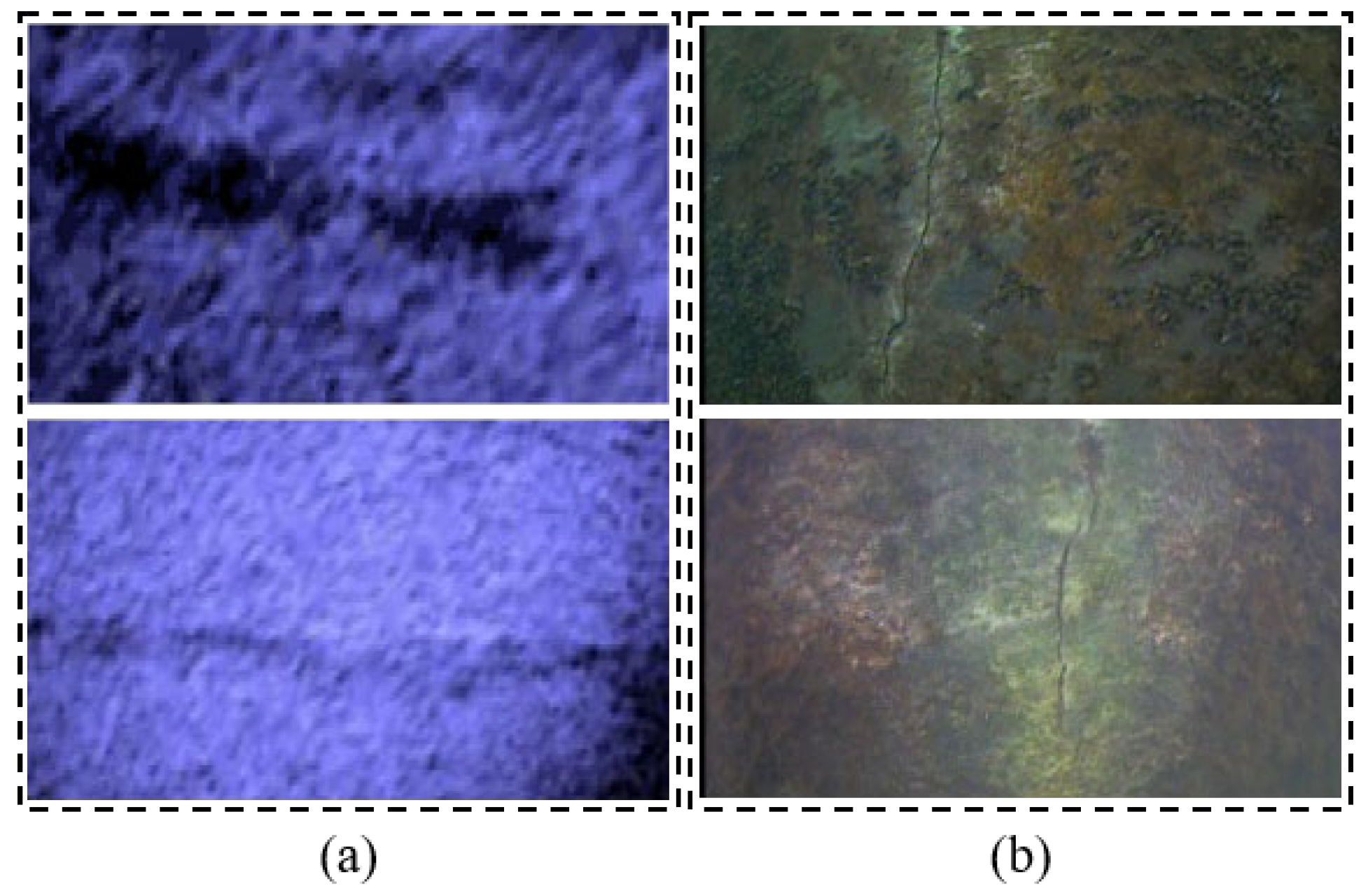
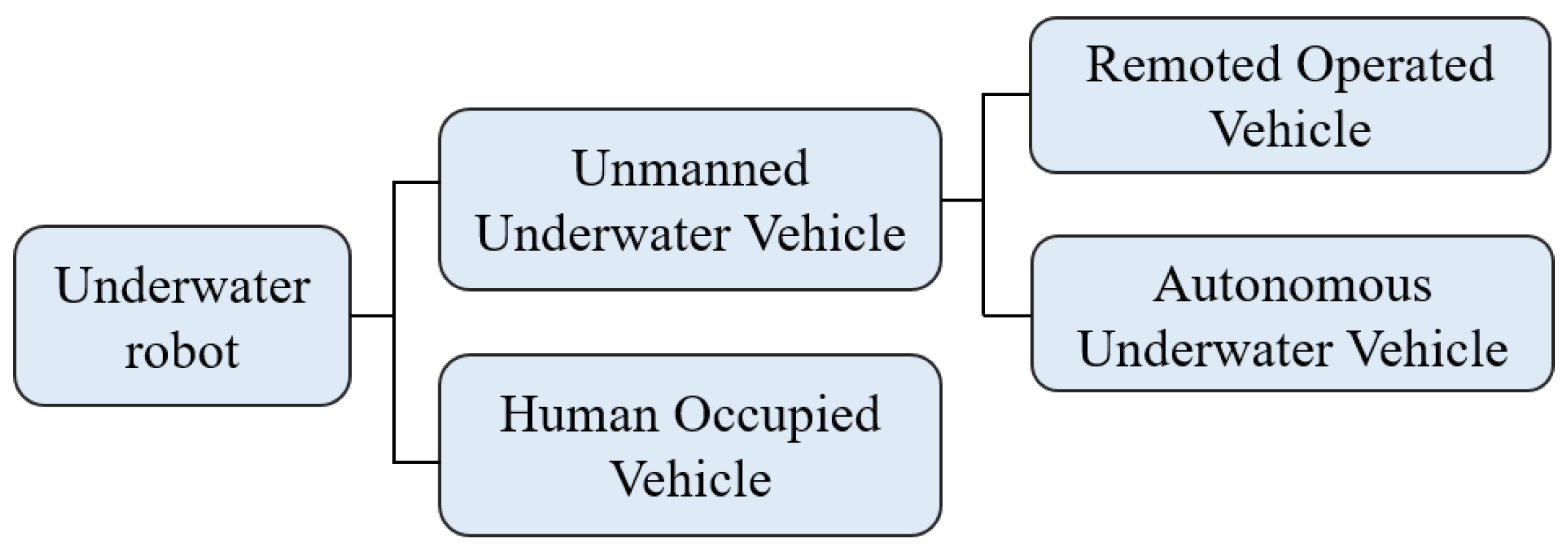

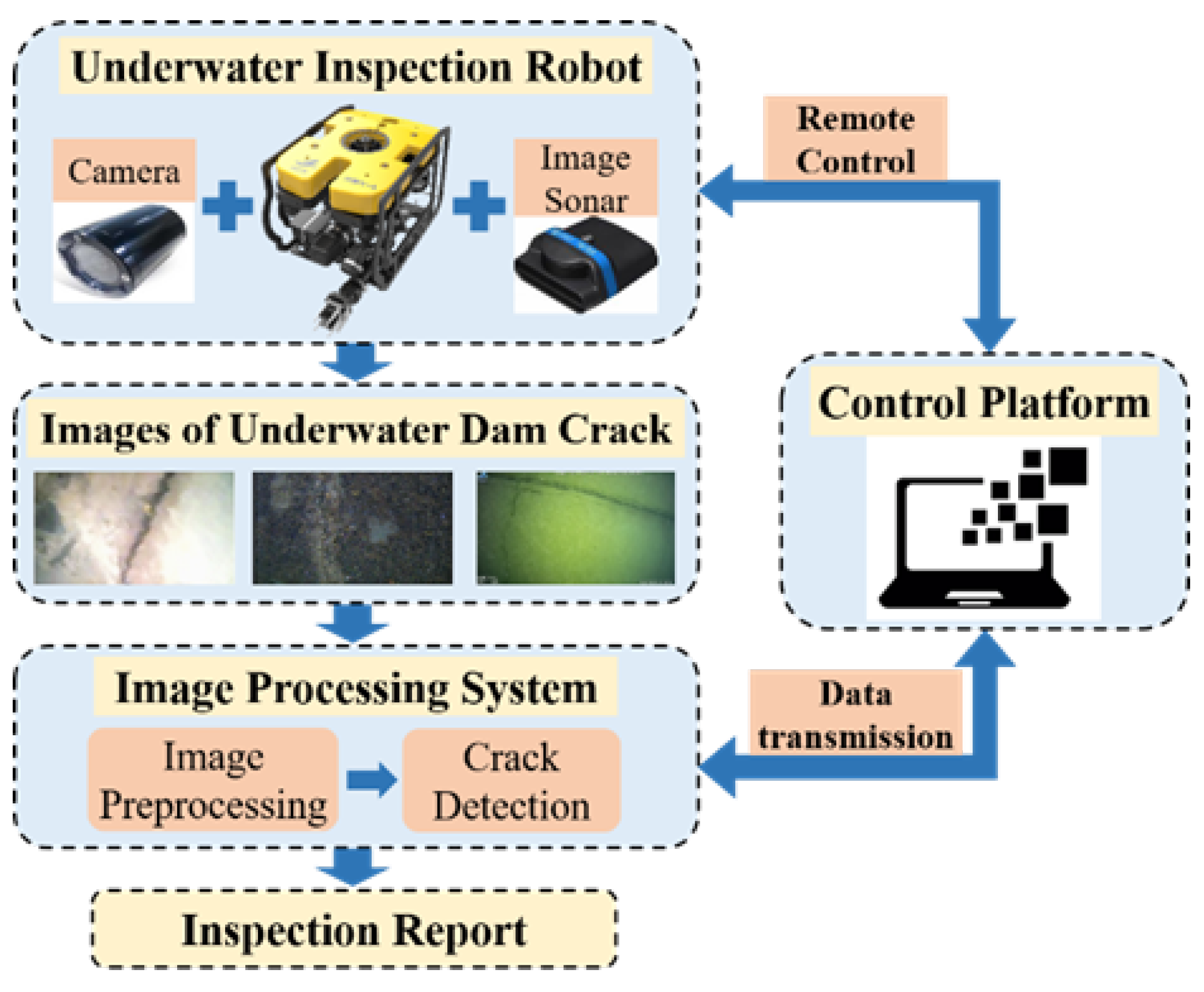
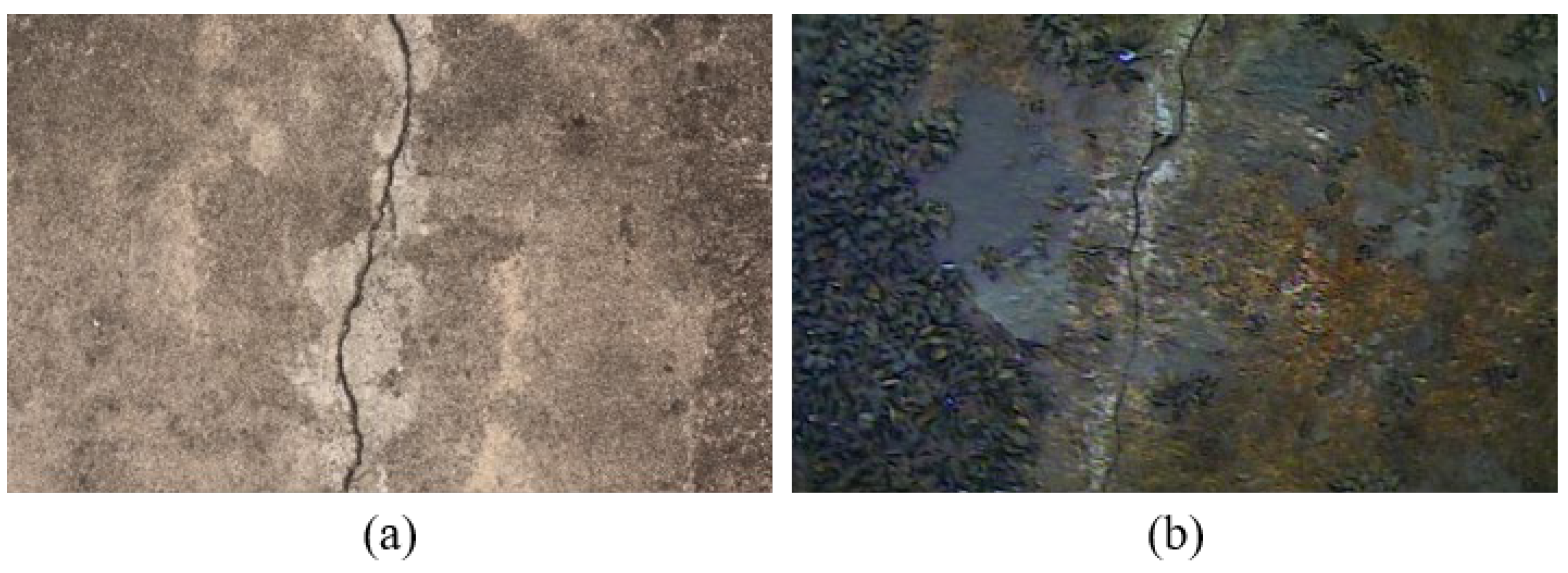
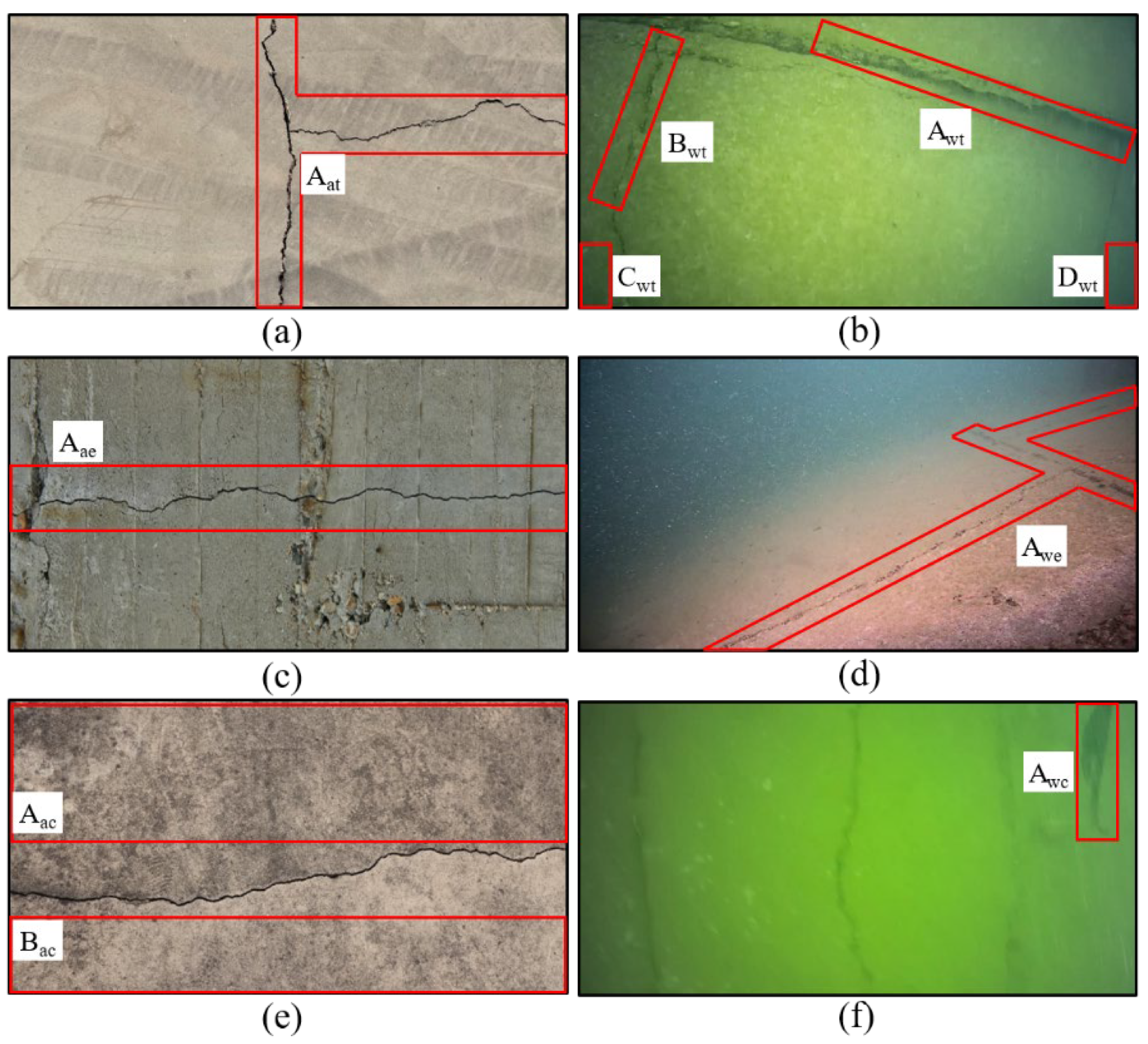
| Author and Year | Approaches/Methods | Results |
|---|---|---|
| Xin et al. [46], 2023 | Affine shadow transform-based methods and adaptive histogram equalization | The processed image gets uniform illumination. |
| Ma et al. [32], 2022 | Affine shadow transform-based methods | The color deviation of the processed image is small and the definition of the processed image is improved. |
| Wan et al. [76], 2019 | Methods based on biological principles | The image adaptively homogenizes the global brightness of the image according to its overall brightness distribution without human intervention. |
| Zhang et al. [74], 2018 | Adaptive enhancement method based on the principle of biological vision | The proposed method enhances the grayscale contrast at the edges of faint objects at different brightness conditions. |
| Fan et al. [71], 2018 | Coarse set-based methods | Obtained an image with balanced background lighting. |
| Shi et al. [25], 2016 | Affine shadow transform-based methods | The proposed method eliminates the inhomogeneous illumination and well-preserves the crack texture in the image. |
| Ma et al. [75], 2016 | Dark channel-based enhancement algorithms | The proposed method can effectively suppress the noise interference of underwater images and improve the clarity of underwater dam crack images. |
| Author and Year | Approaches/Methods | Results |
|---|---|---|
| Xin et al. [46], 2023 | Method of combining local features with global features | The proposed method can detect cracks well in low contrast, complex backgrounds, and uneven illumination conditions. |
| Ma et al. [32], 2022 | Binocular vision method | The proposed method can quickly determine the crack width. |
| Cao and Li [26], 2022 | An improved As-Projective-As-Possible algorithm and graph convolutional neural network | The proposed method achieves stitching of small images to obtain the full shape of underwater cracks. The image segmentation algorithm is highly accurate for cracks in different regions, different water depths, and different degrees of deformation. |
| Li et al. [37], 2022 | Lightweight semantic segmentation network and two-stage hybrid transfer learning algorithm | The proposed method enables the construction of pixel-by-pixel segmentation models of underwater cracks in the presence of limited samples. |
| Fan et al. [72], 2022 | Multilevel antagonism transfer network and improved U-net image segmentation network | The proposed method achieves accurate segmentation of underwater dam crack images, but its real-time performance is poor. |
| Qi et al. [83], 2022 | Convolution neural network and Ostu algorithm | The proposed method can efficiently detect and localize cracks in underwater optical images at low illumination, low signal-to-noise ratio, and low contrast. |
| Mucolli et al. [20], 2019 | Local features: Haralick texture features | The proposed method has high accuracy, robustness to illumination, and reasonable computational efficiency. |
| Wan et al. [76], 2019 | Binocular vision method | The proposed method can obtain the spatial information of defects. |
| Fan et al. [71], 2018 | Methods of combining local features with global features | The proposed method can effectively detect cracks in complex environments without supervision. |
| Zhang et al. [74], 2018 | Edge detection model based on artificial bee colony algorithm | The proposed method can detect dam crack defects in complex underwater environments. |
| Shi et al. [53], 2017 | Crack detection algorithm based on clustering analysis and tensor voting | The proposed method can accurately and efficiently detect and classify underwater dam cracks in complex underwater environments based on sonar images. |
| Shi et al. [25], 2016 | Method of combining local features with global features | The proposed method can accurately and efficiently detect and classify underwater dam cracks in complex underwater environments. |
| Chen et al. [77], 2012 | Adaptive underwater dam surface edge detection algorithm based on multi-structure and multi-scale elements | The proposed method can effectively remove noise and maintain image edge details. |
| Chen et al. [78], 2012 | Morphology-based method | This method enables accurate and efficient detection and classification of underwater dam cracks in complex underwater environments. |
Disclaimer/Publisher’s Note: The statements, opinions and data contained in all publications are solely those of the individual author(s) and contributor(s) and not of MDPI and/or the editor(s). MDPI and/or the editor(s) disclaim responsibility for any injury to people or property resulting from any ideas, methods, instructions or products referred to in the content. |
© 2023 by the authors. Licensee MDPI, Basel, Switzerland. This article is an open access article distributed under the terms and conditions of the Creative Commons Attribution (CC BY) license (https://creativecommons.org/licenses/by/4.0/).
Share and Cite
Chen, D.; Huang, B.; Kang, F. A Review of Detection Technologies for Underwater Cracks on Concrete Dam Surfaces. Appl. Sci. 2023, 13, 3564. https://doi.org/10.3390/app13063564
Chen D, Huang B, Kang F. A Review of Detection Technologies for Underwater Cracks on Concrete Dam Surfaces. Applied Sciences. 2023; 13(6):3564. https://doi.org/10.3390/app13063564
Chicago/Turabian StyleChen, Dong, Ben Huang, and Fei Kang. 2023. "A Review of Detection Technologies for Underwater Cracks on Concrete Dam Surfaces" Applied Sciences 13, no. 6: 3564. https://doi.org/10.3390/app13063564
APA StyleChen, D., Huang, B., & Kang, F. (2023). A Review of Detection Technologies for Underwater Cracks on Concrete Dam Surfaces. Applied Sciences, 13(6), 3564. https://doi.org/10.3390/app13063564






